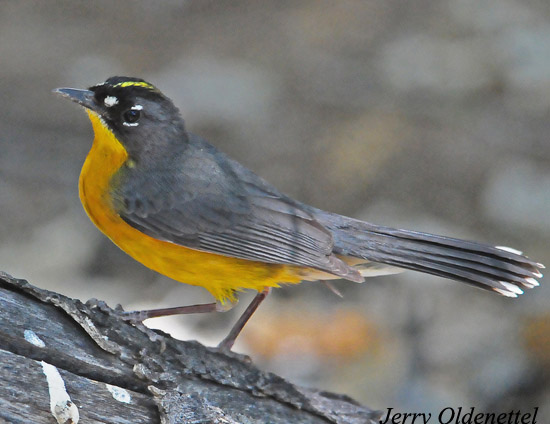| Length: 6 inches | Wingspan: 8.5 inches | Seasonality: Non-resident in South Dakota |
| ID Keys: Blackish top/front of head, yellow crown stripe, white lore spot, white crescents above/below eyes, yellow below | ||
 The
Fan-tailed Warbler's normal range is from northwestern Mexico to northern
Guatemala. They are known in the United States from a handful of sightings,
including one in Big Bend National Park in Texas, and a few in far southern
Arizona and New Mexico. It is named for its habit of flicking and
fanning its long tail as it forages on the ground or low in vegetation,
displaying the bold white spots at the end of its tail.
The
Fan-tailed Warbler's normal range is from northwestern Mexico to northern
Guatemala. They are known in the United States from a handful of sightings,
including one in Big Bend National Park in Texas, and a few in far southern
Arizona and New Mexico. It is named for its habit of flicking and
fanning its long tail as it forages on the ground or low in vegetation,
displaying the bold white spots at the end of its tail.
Habitat: Found at the edges of mixed or evergreen forest, often in forested canyons and ravines. They strongly prefer to be near areas with thickets or an undisturbed forest understory.
Diet: Feeds on insects, spiders, and other small invertebrates. Ants are a favorite food item. They will also sometimes feed on berries or nuts.
Behavior: Tends to forage on the ground or low in vegetation rather than up in the forest canopy, particularly given its preference for feeding on ants. Food is gathered by walking along the ground, or by clambering through vegetation and gleaning insects and other prey.
Nesting: The nest is a cup of pine needles, grasses, leaves, and other vegetation, placed on the ground, often hidden under leaf litter or vegetation. The female lays 2 to 4 eggs, and she alone incubates them. The young hatch after about 2 weeks.
Song: Song is a repeated series of clear whistles that rises sharply on the last note
Migration: Considered a permanent resident in most of its range, populations in the far northwestern Mexico are migratory and will move south for the winter.
Interactive eBird map: Click here to access an interactive eBird map of Fan-tailed Warbler sightings
Similar Species: Unique plumage characteristics make it distinctive if seen well.
Feeders: Has been known to attend feeders for fruits and nuts.
Conservation Status: Populations are seemingly declining, but the overall population is still strong. The IUCN lists the Fan-tailed Warbler as a species of "Least Concern".
Further Information: 1) BirdLife International - Fan-tailed Warbler
2) WhatBird - Fan-tailed Warbler
3) Cornell's NeoTropical Birds - Fan-tailed Warbler
Photo Information: Photo by Jerry Oldenettel - Photo licensed under Creative Commons Attribution NonCommercial ShareAlike 2.0 Generic License
| Click below for a higher-resolution map |
 |
| South Dakota Status: Non-resident in South Dakota |
Additional Fan-tailed Warbler Photos (coming soon!!)
